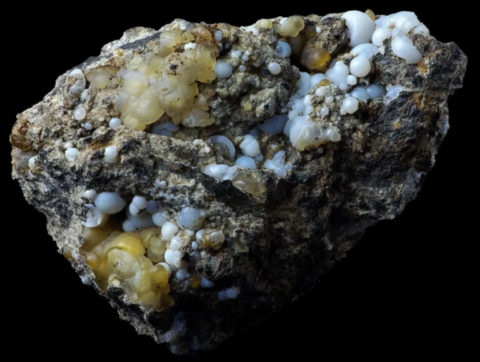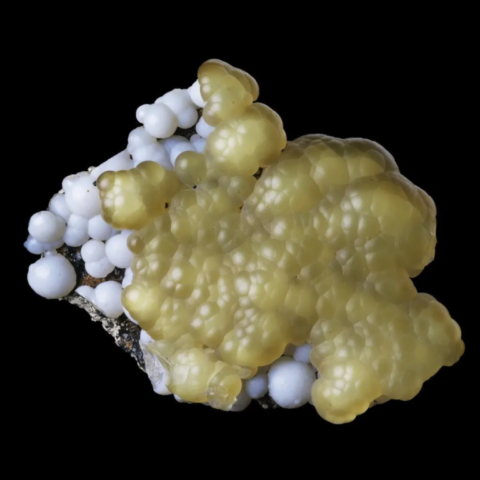Lussatite from Lussat - France
Lussatite, a microcrystalline variety of silica, was first identified in 1890 by E. Mallard in the bitumen deposit near the village of Lussat, Puy-de-Dôme, France. This site, which has now disappeared, represents a milestone in the history of French mineralogy. Today, lussatite is recognized as an opal-CT, a disordered combination of cristobalite and tridymite, two polymorphs of silica.
Right photo : Lussatite and yellow chalcedony balls on bituminous wakite from Lussat, Puy-de-Dôme, France © Rémi Bornet
Mallard's initial observations (1890)
E. Mallard observed that lussatite occurs as spherules in the Lussat bitumen deposit. Studying thin sections, he noticed a fibrous structure and distinctive optical properties :
Very low birefringence, appearing black to first-order gray.
Straight extinction.
Positive optical sign of elongation.
The density of lussatite is measured at 2.04 using a dense liquor, and its mean refractive index reaches 1.446. Mallard notes that this substance is never totally pure, and is always accompanied by amorphous silica, then called “opal”.
Novák's scientific breakthroughs (1932)
In 1932, J. Novák used X-ray diffraction to further characterize lussatite. He describes it as a “cristobalitic chalcedony”, composed of approximately :
30% β-cristobalite (high temperature).
70% α-crystobalite (low temperature).
This discovery reinforces the idea that lussatite represents a complex variety of crystalline silica.
Modern reinterpretation: CT-opal
More recent research, notably by Flörke (1991) and reported by Graetsch (1994), has redefined lussatite as CT-opal. The term refers to a disordered mixture of cristobalite and tridymite fibers. These two minerals, stable at high temperatures, appear in disordered forms in low-temperature contexts, such as flint or certain opals.
The Lussat deposit : a lost heritage
Considered to be the standard locality for this variety of silica, the Lussat deposit was destroyed in 1969, and virtually nothing remains of it today. It was an open-cast quarry located to the east of the village of Lussat, in a volcanic unit consisting of a breccia very rich in bitumen (bituminous wakite). The lussatite in this deposit came in the form of small, opalescent bluish or yellow pearls of very fine quality. Although a difficult-to-access outcrop remains, it is currently virtually impossible to find it in the field.
Conclusion
Although the Lussat deposit no longer exists, the discovery of lussatite remains a milestone in the study of silica. From its initial observations by Mallard to its reinterpretation as a CT opal, this mineral illustrates the evolution of scientific knowledge and the importance of interdisciplinary research in mineralogy.
References :
BORNET, R. (2009). La lussatite, une variété microcristalline de silice. TER Université Blaise Pascal de Clermont-Ferrand.
Collectif. (2015). La lussatite, l’opale d’Auvergne et autres trésors de la Limagne (Puy-de-Dôme). Hors-série n°21 de la revue Le Règne Minéral. Éditions du Piat, 84 pages
FLÖRKE, O. W., GRAETSCH, H., MARTIN, B., RÖLLER, K., WIRTH, R., (1991). - Nomenclature of micro- and non-crystalline silica minerals, based on structure and microstructure, Neues Jahrbuch Miner. Abh., 163, pp. 19-42.
GRAETSCH, H., (1994). - Structural characteristics of opaline and microcrystalline silica minerals. Silica : physical behaviour, geochimistery and materials applications. Edité par Heaney P. J., Prewitt C. T., et Gibbs G. U., pp. 209-232.
Mallard, E. (1890). Sur la lussatite, nouvelle variété minérale critallisée de silice. Bulletin de la Société française de Minéralogie, tome n°13, pp. 63-66.
NOVÁK, J. (1932) Cristobalite from Serpentines of West Moravia. Publication de la Faculté des Sciences de l'Université de Masaryk, n°155, pp. 3-9.



